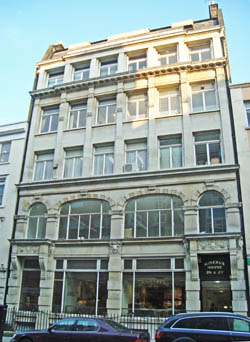Specialist
In 1851, with the existing Royal Orthopaedic Hospital under pressure of numbers, plans were laid for a second establishment.
A lease on No. 27 Hatton Garden was obtained and the City Orthopaedic Hospital opened to out-patients on 24th June 1851. In the following year 6 beds were made available.
Over the next decades finance and management were often uncertain but, by 1885, there was a little more stability. The premises at the rear in Charles Street, previously rented out, were partly adapted as a reception area and dispensary, while the old reception room became the Board Room and an additional ward was created from the former Board Room.
With the existing lease about to expire, in 1890 the Hospital scraped together the funding to buy the freehold of No. 27 and No. 26 (the house next-door which had been rented out initially) and the rear Charles Street premises. With some extra funds coming in (the Skinners Company had voted £1,000 towards the cost of the opening the vacant wards and building a new Out-Patients Department), plans were laid for refurbishment and some extensions. Fortuitously, a diphtheria outbreak in 1898 closed the Hospital temporarily, providing an opportunity to carry out these works efficiently.
At the end of 1898 Dr Frank Simpson Pepperdene (1862-1933), a pioneer radiologist, offered to set up an X-ray Department at the Hospital at his own expense, subject to his being appointed to the staff. The Hospital Committee agreed and the arrangement continued until about 1901, when Dr Pepperdene moved to Bexhill-on-Sea.
The Hospital was officially reopened in July 1899 by the Duke of Cambridge. The ceremony was held in the hall of the new Out-Patients Department, which also contained a small dispensary.
The Hospital now had 45 beds in two wards - male and female. A new operating room had been installed at the top of the building and was equipped with the latest approved apparatus.
Although a new sitting room had been added for the nurses, their sleeping accommodation was less than adequate, consisting of a large room divided by curtains. The Hospital also lacked adequate storage space, having very few cupboards. The fine oak panelling and carvings in the older part of the building had been painted over with cream paint.
One room of the Hospital contained a museum of 'before' and 'after' models of the deformities which had been treated there.
In 1903 the Hospital Committee was involved in discussions, led by the King's Fund which was attempting to rationalise the provision of orthopaedic services in London, regarding amalgamation with the Royal Orthopaedic Hospital and the National Orthopaedic Hospital. Since its buildings had recently been refurbished, the Committee declined to be involved with such a merger.
However, the financial situation of the Hospital was deteriorating rapidly. Its buildings were valued at £18,000, with a permanent mortgage of £6,000 at 4%. The medical staff reluctantly joined the management in agreeing to merge the Hospital with the new Royal National Orthopaedic Hospital.
The Hospitals amalgamated on 11th July 1906, with the seven members of the existing Committee of Management joining the management of the Royal National Orthopaedic Hospital.
The Hatton Garden buildings were vacated in 1907.
Present status (February 2012)
Before the building was demolished in 1907, the oak panels and carvings of the Panelled Room were removed and taken to the Victoria and Albert Museum, where they reside today packed away in crates.
The site now contains Minerva House, a business centre mainly for diamond and gem dealers.

Minerva House.
(Author unstated) 1898 Reflections from a Board Room mirror. British Journal of Nursing, 26th March, 258.
(Author unstated) 1899 City Orthopaedic Hospital. Nursing Record and Hospital World, 2nd September, 193.
www.cityoflondon.gov.uk
Return to home page